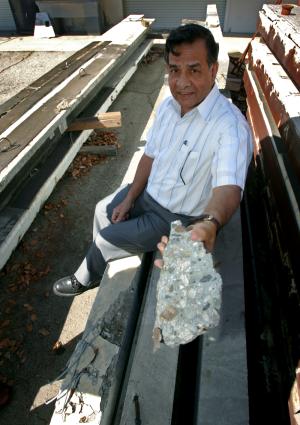It’s a Wrap
Less May Be More When it Comes to Expensive Construction Fabric
For repairing or reinforcing concrete and steel structures, carbon fiber-reinforced polymer fabric – a specialized plastic that becomes rigid and stronger than structural steel – is greener, easier and quicker to apply, takes less-skilled labor, adds less weight to a building and is often more corrosion-resistant than traditional methods … yet it isn’t the go-to material even when it could do the job.
The reason is its expense — upwards of $1,200 a roll, plus needed adhesives and resins. So crews and companies specializing in reinforcement and repair usually use slower, more polluting, more labor-intensive methods with steel and concrete, which can be so heavy that other parts of the building may need bolstering, as well.
Research by Pinaki Chakrabarti, professor of civil and environmental engineering, has found that sometimes significantly less fabric can be used to get the same effect, making its use cheaper in the long run.
Chakrabarti and his collaborators crushed concrete beams, slabs and beam-column joints with hydraulic crushers in combinations of non-fiber reinforced, fully and partially reinforced, and undamaged and fiber-repaired pieces, before reaching their conclusions.
His research has demonstrated that less of the polymer still worked as designed: sometimes the entire length of a damaged beam can be reinforced only on one side with the material. Under other circumstances, Chakrabarti has established, reinforcing or wrapping the middle portion is enough.
“Dr. Chakrabarti’s research affirms what we’ve believed for awhile,” said Tom Sabol, a structural engineer and principal of the international firm Englekirk & Sabol Consulting Structural Engineers, Inc., the principal engineer for Cal State Fullerton’s north campus housing project completed in 2002 and the under-construction phase 3 student housing project scheduled for completion in 2011.
“In 1998, our firm worked on the seismic reinforcement of UCLA’s Arroyo Bridge,” said Sabol. “Using steel and concrete would not have worked well. We found we needed some reinforced fiber polymers the full length of the columns and only at the ends did they need a heavy reinforcement treatment with the fiber. On the beams, we found we needed to reinforce only the middle third, not all of the way across. That cost less and took less time. And the first cost, that is, the cost of the fiber, isn’t necessarily the whole story.
“If the job can be done more quickly, with less labor and lasts longer, in the long-term, it’s cheaper. We rejuvenated a parking structure at UCLA in 2009 using fiber-reinforced polymers and it cost under a half-million.” If they had put in new shear walls to hold the structure’s weight, then the necessary concrete and steel reinforcing for the shear walls, Sabol said, “It could have cost millions.”
Englekirk is now planning the rejuvenation of another UCLA parking structure and plans to use reinforced fiber polymers again, Sabol said.
There is more work to do, Chakrabarti said. The material’s reaction to prolonged heat and cold, chemicals like road salt in winter near repaired bridges and extended exposure to the sun’s ultraviolet rays, need to be documented before widely accepted standards for all types of situations can be put into place.
“But certainly, if in a reasonably protected place, it can be a cleaner, quicker, easier, longer-lasting material to use,and not as much is needed as originally thought,” Chakrabarti added.
Nov. 30, 2010
 Pinaki Chakrabarti, professor of civil and environmental engineering, displays a portion of a concrete beam that was put under stress in a beam crusher as part of his research on the use of carbon fiber-reinforced polymer fabric. Photo by Karen Tapia
Pinaki Chakrabarti, professor of civil and environmental engineering, displays a portion of a concrete beam that was put under stress in a beam crusher as part of his research on the use of carbon fiber-reinforced polymer fabric. Photo by Karen Tapia 